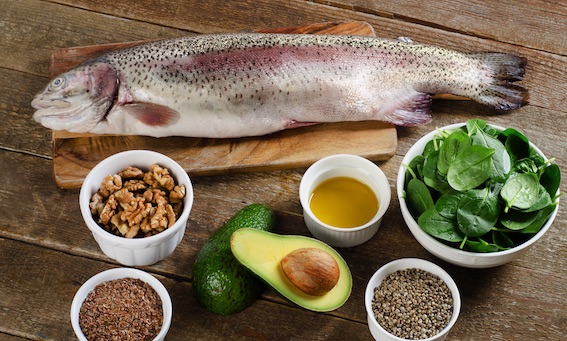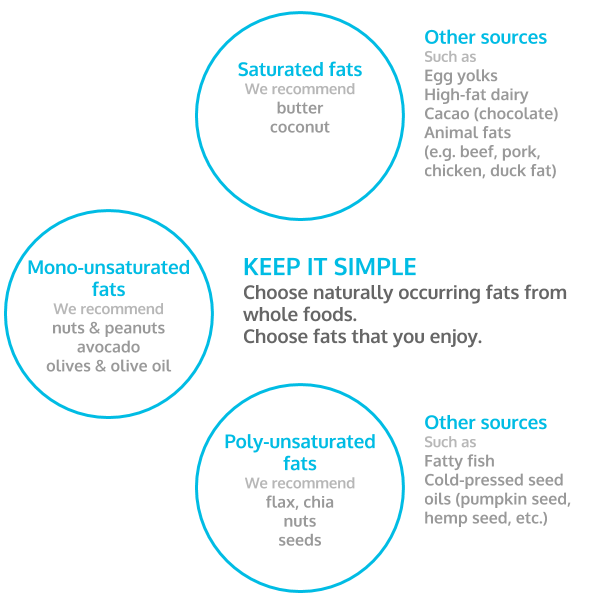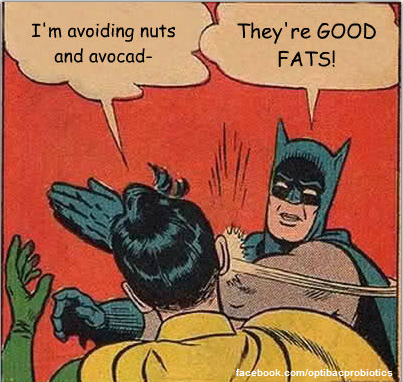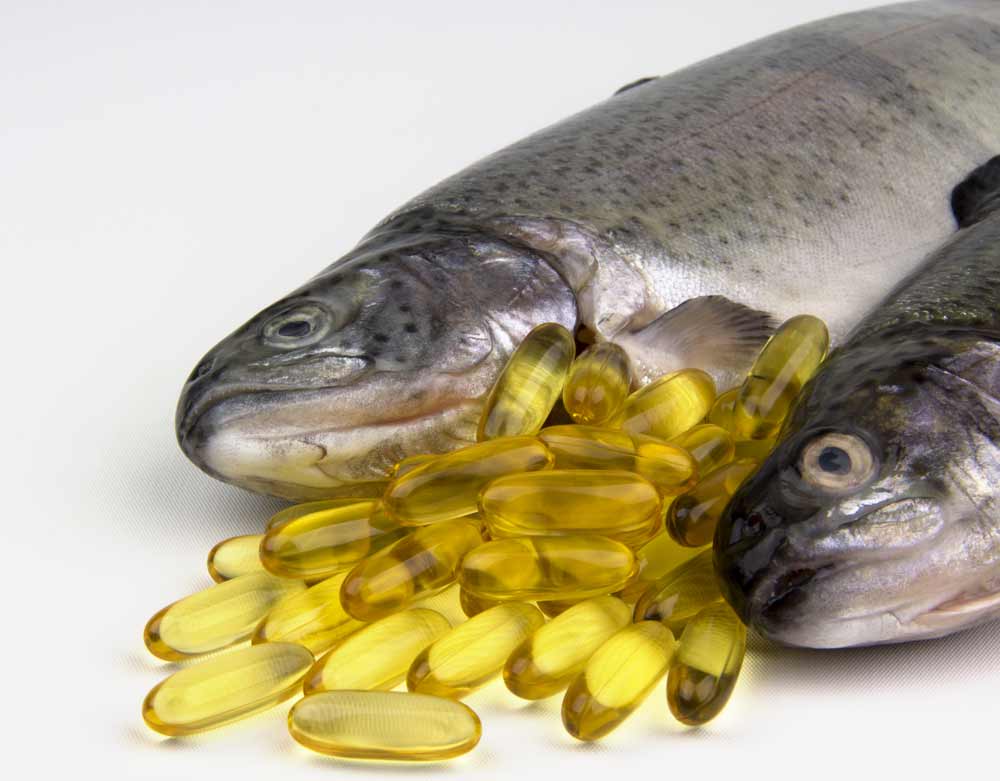
Optional Accelerated Habit – Week 9
Habit : Eat Healthy Fats – PART 2 – What makes fats Healthy AND the benefits of Omega 3!
(Why are healthy fats so good for us?)
What makes these fats Healthy?
You’ll notice that the list of fats we gave you are:
Naturally occurring
such as the fat in olives, nuts and seeds
Relatively minimally processed
either they’re whole foods, or they’ve been simply pressed or ground
These are the kinds of fats that keep your hormones healthy, your brain happy and smart, your fatty tissues (such as your eyes and skin) well-lubed, and your body chemistry working as it should.
When you eat healthy fats, you feel good, perform well, and recover easily.
Plus stuff tastes really good. (Avocado, nut butter, and coconut! And a little bit of dark chocolate… nice!)

What makes other fats unhealthy?
Now, there are some fats you should try to eat less of.
These fats tend to increase inflammation, risk of heart disease and cancer, and other nasty things.
What makes these particular fats “unhealthy”?
Unlike healthy fats, you’ll notice that these unhealthy fats:
- don’t naturally occur in the foods they’re found in; and
- have to be created through an industrial process.
Trans fats
Trans fats are created in an industrial process that forces hydrogens into vegetable/seed oils, which makes them more solid.
Look for the terms partially hydrogenated or vegetable shortening.
These tell you that there are trans fats in the product, even if the product lists 0 g of trans fats per serving. Those sneaky devils are allowed to do so if the serving contains less than 0.5 g.
You can also look for mono and diglycerides on the label, which are other processed forms of fat used as emulsifiers.
Many foods contain a lot of trans fats, including:
- margarine or processed oils, such as cooking spray;
- regular peanut butter;
- fried or battered foods;
- pie crust and other baked goods; and
- frozen dinners and other processed foods.
- Biscuits
- Basically if its processed food… READ THE LABEL
Some foods, such as dairy and beef, contain naturally occurring trans fats. These naturally occurring trans fats don’t seem to be a problem, and some research suggests they may actually be good for us.
(Again, notice how when fats naturally occur in food, they are usually healthy.)
There is no amount of industrial trans fat consumption that is recognized as safe.
Do your best to minimize your intake. (Of course, it’ll be a work in progress. That’s okay.)
Industrial vegetable/seed oils
Then, there are other kinds of oils that we can only create with industrial processing.
These oils include:
- vegetable oil;
- sunflower oil;
- palm oil;
- soybean
These oils undergo a lot of processing to actually become edible: High heat and harsh chemicals (such as bleaches, solvents, and deodorizers) strip them of many nutrients.
Because of the heat and processing these oils undergo, they can have significant amounts of trans fats in them.
Many foods are made with these industrial vegetable/seed oils, including:
- commercial salad dressing;
- commercial mayonnaise;
- butter substitutes;
- fried and battered foods; and
- most processed foods.
Now remember: We don’t have “good” and “bad” foods…
You don’t have to eliminate trans fats or vegetable/seed oils entirely.
Having some restaurant salad dressing or regular peanut butter on occasion won’t kill you.
It’s what you do consistently that matters. (there it is again:)
Level 2 Eaters option (Balancing your fats)
If you’re a Level 1 eater, just keep things simple and keep choosing a variety of healthy fats.
In fact, we recommend you skip this section.
If you’re a Level 2 eater, consider the balance between saturated, monounsaturated and polyunsaturated fats.
We recommend that you get a more-or-less even mix of all three.
While this might seem intimidating to do, it’s actually pretty easy.
Just choose a variety of your healthy fat options from the list along with other whole foods (such as eggs, meat and fish).
That should balance your intake nicely.

The Benefits of Omega-3s
So far, we’ve learned all about fats: Good fats, not-so-good fats, how to put them into a meal, and how much to eat.
But there are fats that we haven’t really discussed yet: The incredible omega-3s.
Which may just be the best fats of all.
What are Omega -3 fats?
Omega -3 fats are a type of extra healthy fat found particularly in:
A few types of nuts and seeds
such as flax seeds, chia seeds, walnuts, and hemp
Marine Life
Such as cold water fish, shellfish and algae

Interesting Fact!
Omega-3 fatty acids help keep cold-water marine life from freezing.
Because they stay liquid at low temperatures, omega-3s are like natural antifreeze.
Cool… literally
Omega-3s come in different forms.
(This is not important unless you like science. So if you don’t care or this just seems confusing, feel free to skip this bit.)
The most important omega-3 fats are the following:

ALA (alpha-linolenic acid)

DHA (docosahexaenoic acid)

EPA (eicosapentaenoic acid)
Most plant-based sources (e.g. flax, walnuts, and chia) are rich in ALA while marine sources (such as fish and algae) are rich in EPA and DHA.
Our bodies mostly use DHA/EPA, though ALA has some unique benefits of its own.
ALA can be converted to DHA/EPA, but most people convert very little of it. So it’s hard to get enough DHA/EPA from most plant sources like flax seeds.
We’ll give you some suggestions for improving your omega-3 fats below
Why are omega-3 fats good?

Omega-3 fats do all kinds of awesome things for the body.
For instance, they can:

Keep our hearts and brains healthy

Lower inflammation

Improve our cells' communication

Keep joints mobile

Help us stay lean

Help build muscle
There is strong evidence that omega-3s can:
- improve your blood lipids (like triglycerides and HDL-C)
- help reduce some symptoms of depression and anxiety
- help reduce some ADHD symptoms
- help regulate our metabolism and blood sugar
And other evidence, though not as strong for:
- preventing cancer
- preserving memory
- eye health
- decreasing liver fat
Fats: Your body’s signal system
Not all fat we eat gets stored on our bellies and butts.
Our bodies like to use healthy fats to do other important stuff, such as:
- Make fat-based tissues, like our brains and the fatty sheath that insulates our spinal cord and nerves.
- Make many hormones, such as testosterone and estrogen.
- Make the membranes for all our cells.
So the fat we consume literally becomes part of every one of our cells.
Fat can powerfully influence how our cells communicate and interact.
For example, fat can affect signaling molecules that influence blood vessel constriction, inflammation, blood clotting, pain, airway constriction, etc.
Since our brains are fat-based, changes in fat composition can affect how nerve impulses are transmitted. This can affect our moods, how well we think, our overall mental health, and even our brain’s longevity.
And omega-3s may be some of the most powerful and important fats for our bodies.
Should you supplement with omega-3 fats?

As always – the answer to this question depends on you.
If you’re a Level 1 eater just trying to get the hang of healthy fats:
Keep it simple.
Focus on getting a range of healthy fats from whole foods such as nuts, seeds, avocados, etc. (Check our healthy fats list for guidelines.)
And if you like fish, try bringing it into your life more regularly: A little sushi here, a little smoked salmon there… it adds up (and tastes good).
Don’t worry about anything else for now.
If you’re a Level 2 eater:
Consider adjusting your omega-3 fat intake.
Do you consistently eat fatty cold-water fish like salmon, mackerel, herring, or sardines two to three times per week?
Our guess: If you don’t live in Japan, Crete, Scandinavia, some other coastal fishing village, or up in the Arctic where you’re hunting your own seal and whale to eat, you probably don’t.
If you’re a Level 2 eater and not regularly eating fatty fish, then consider omega-3 supplementation as a Level 2 strategy.
Fish oil
Supplement daily with 3–6 grams of total fish oil, giving you around 1–2 grams of total EPA+DHA.
This dose is high enough to give you all the health benefits listed above, but very safe.
Krill/algae oil
You can also supplement with krill oil or algae oil (which is plant-based) instead.
With these products, use smaller doses: Aim for 300 mg of total EPA+DHA from these.
While eating plenty of flax seeds, chia seeds, and walnuts, and maybe taking a little flax oil are good things, they don’t replace eating or supplementing with EPA and DHA.
We typically don’t recommend you supplement with flax oil pills. You’re better off eating the ground seeds, and taking fish oil instead.
Summary of recommendations
Here’s a recap of our healthy fat recommendations.
- If possible, start by eating more fatty fish.
- Eat other naturally occurring fats, such as avocados, coconuts, nuts and seeds.
- Cut way down on industrial vegetable/seed oils.
If you’re a Level 1 eater, stop here.
If you’re a Level 2 eater, and you’re considering omega-3 supplementation:
- Read the label on your omega-3 supplement to see the total EPA/DHA.
- Fish oil: Take whatever dose will give you 1–2 grams of total EPA/DHA (about 3–6 grams for most commercial formulations)
- Krill or algae oil (plant-based): Take whatever dose will give you 300 mg total EPA/DHA.
- Other omega-3 plant sources (such as flax or chia seeds) won’t give you the EPA/DHA you need. But feel free to eat them as whole foods.
That’s it.